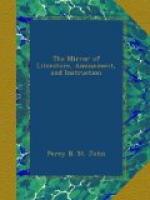(
Cyprinus
Phoxinus,
L.), of which
they are very fond. At this time, they are angled
for by spinning a minnow; but, in a general way, the
sport is indifferent, and the persevering angler is
well rewarded if he succeed in killing two brace a
day. A more successful mode of taking them is
by fastening a long and heavily leaded line, and hook
baited with a minnow, to the stern of a boat, which
is slowly and silently rowed along: in this way
they are taken during the early summer months; but
when the hot weather comes in, they are seldom seen.
They feed, probably, at night; and although they never
leave the lake, except during the period of spawning,
nothing is more uncommon than taking a char in July
and August. When in season, they are strong and
vigorous fish, and afford the angler excellent sport.
They differ little in size, three fish generally weighing
about 2lbs.: occasionally, one is caught larger,
but they seldom vary more than an ounce. The
char, as it is well known, is a singularly beautiful
fish, and is accurately described by Pennant.
The fishermen about the lakes speak of two sorts,
the case char and the gilt char; the latter being
a fish that has not spawned in the preceding season,
and on that account said to be of a more delicate
flavour, but in other respects there is no difference.
* * * *
*
DUTCH RUSHES.
The Equisetum hyemale, is commonly sold under
the name of Dutch rushes, for the purpose of polishing
wood and ivory. If the rush be burnt carefully,
a residuum of unconsumable matter will be left, and
this held up to the light will show a series of little
points, arranged spirally and symmetrically, which
are the portions of silex the fire had not dissipated;
and it is this serrated edge which seems to render
the plant so efficient in attrition. Wheaten
and oaten straw are also found by the experience of
our good housewives to be good polishers of their brass
milk vessels, without its being at all suspected by
them that it is the flint deposited in the culms which
makes it so useful.—Magazine of Natural
History, March.
* * * *
*
WOLF-DOG.
In Hutton’s Museum at Keswick, is a large stuffed
dog (very much resembling a wolf, and having its propensities),
which some years ago spread devastation amongst the
flocks of sheep in this neighbourhood: a reward
was offered for its destruction, and, though hunted
by men and dogs, its caution and swiftness eluded
their pursuit, till it was found asleep under a hedge,
and in that position shot.—Corresp.
Mag. Nat. Hist.
* * * *
*
DUCKS.




